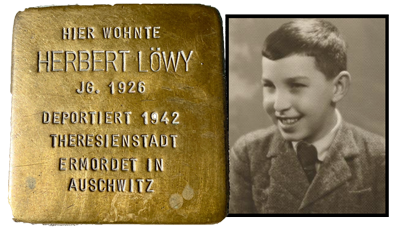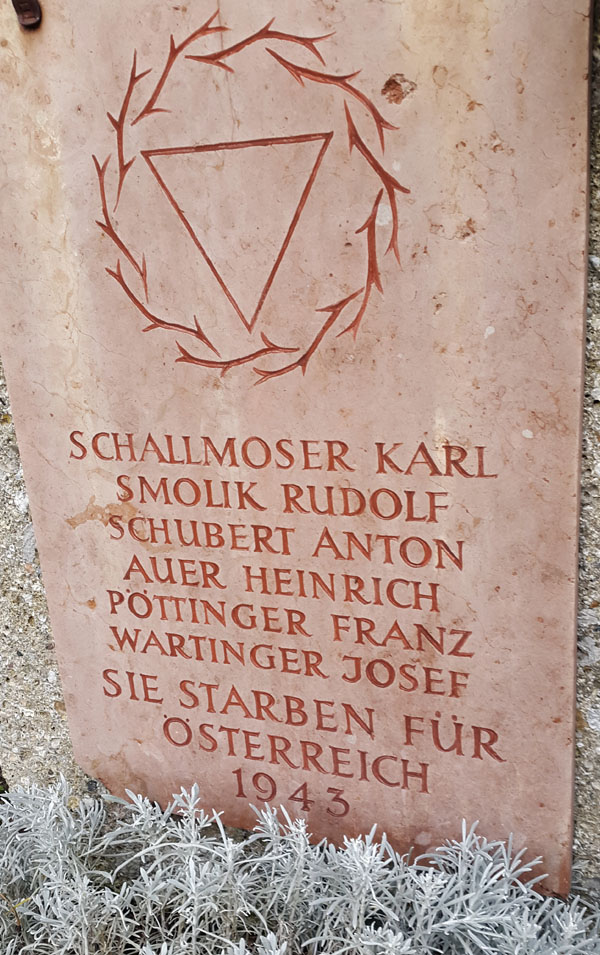Anton SCHUBERT, born on September 19, 1910 in Groß-Kunzendorf (Austrian Silesia, later Czechoslovakia), was a Catholic, the son of a Social Democratic working-class family, an electrical engineer and industrial school teacher by profession, and married to Elisabeth Weinzierl, who had two children: Anton, born on September 16, 1932, and Elisabeth, born on August 19, 1939 in Salzburg.
The SCHUBERT family lived in the Schallmoos district of Salzburg, Stadlhofstraße 8 (formerly the municipality of Gnigl-Itzling).
The plain house belonged half to the brothers Anton and Richard SCHUBERT. Their parents Anton senior and Thekla SCHUBERT lived in Gnigl, Eichstraße 31.
Like his father, Anton junior was a member of the Social Democratic Workers’ Party and the Republican Protection League until they were crushed by the Austrian dictatorship in February 1934.
As a group leader of the Republican Protection League, however, Anton junior was suspected of having hidden weapons. The house search and subsequent interrogation by the Austrian state police did not lead to any criminal prosecution of Anton SCHUBERT.
He was apparently not politically active under the Austrian dictatorship; in any case, he belonged neither to the group of Revolutionary Socialists of Austria (RSÖ) led by Josef PFEFFER nor to the resistance group of the Communist Party of Austria (KPÖ) led by Johann BRANDTHALER and Simon Gröbner.
At least the anti-fascists and opponents of the Austrian dictatorship from 1934 to 1938 who appear in the criminal records are known by name.
Under the Nazi regime, the two resistance groups RSÖ and KPÖ, which were re-established by Engelbert WEISS and Franz OFNER respectively in the war year 1940, were recruited primarily from former Social Democrats who were friends of each other.
The brothers Anton and Richard SCHUBERT decided to join the KPÖ, which was organized in sub-areas, local groups, cells, railwaymen’s, women’s and youth groups. The use of weapons and sabotage were out of the question, as was refusal of military service.
Anton SCHUBERT junior – code name »Max« – was first head of the local communist group in Gnigl and then a member of the provincial leadership of the Communist Party of Austria (KPÖ) with its networks in the province of Salzburg and in the neighboring Innviertel region along the railroad lines.
It is still remarkable that SCHUBERT was able to recruit the secondary school teacher Josef REISCHENBÖCK from the conservative Christian-social milieu for the illegal KPÖ – an isolated case, otherwise the boundaries of social spaces were not crossed.
At the beginning of the war year 1942, the Gestapo succeeded in rounding up and smashing all socialist and communist resistance groups in Salzburg by planting an informer.
In order to stifle any organized resistance movement forever, the Gestapo had nine wives from the local communist groups in Gnigl, Itzling and Hallein deported from the Salzburg police prison to Auschwitz on collective transports.
At least 79 activists from the communist and socialist resistance groups in the city and the province, including the youths Rosa HOFMANN, Franz OFNER and Ernst-Paul STOIBER, perished in concentration camps or penitentiaries.
Anton SCHUBERT was arrested on January 17, 1942, and on April 6, 1943 – together with his comrades Heinrich AUER, Anton REINDL and Karl SCHALLMOSER – was sentenced to death by the »People’s Court« (6th Senate under the chairmanship of Walter Hartmann in the jury courtroom of the Salzburg Regional Court) for »subversion of German military power in connection with traitorous favoring of the enemy and preparation for high treason« and beheaded at the age of 32 in the Munich-Stadelheim penitentiary on July 22, 1943.
His older brother Richard and his wife Maria received a farewell letter:
Dear brother and sister-in-law.
Now I must also say goodbye to you from this world. By the time you receive my lines, I will have served my time in this world. My earthly suffering comes to an end today at 6 o’clock. I leave this world with a clear conscience. May you be granted to survive the war and may a happier future be granted to you.
I have one request to you, dear brother, and especially you, dear sister-in-law, who are closest to my dear wife, comfort my loved ones and support them as much as you can. You must be each other’s comfort and support.
You are not the only ones from whom this war demands sacrifices, and you will also be strong enough to bear these sacrifices. Our suffering will soon be over, but for you it will last your whole life. Make up as you go along, and make life as pleasant for yourselves as possible.
My poor dear mouse [wife] needs a strong support now, and I ask for it from you, dear sister-in-law, also for my dear children. My poor Lisbetherl will wait in vain for her papa.
Now be greeted and kissed for the last time by your Toni.
I have not forgotten Erika [his brother’s daughter] either. Give my warmest regards to all my acquaintances for the last time.
At the request of his mother Thekla Schubert, the Gnigler priest Franz Dürnberger read a mass, after which he was deported to the Dachau concentration camp, where he was liberated in April 1945.
Anton’s brother Richard SCHUBERT, who had been sentenced to eight years in prison for resistance, also survived the terror years. Her father died during the war in 1944, her mother after the liberation in 1951.
Shortly after the liberation of Salzburg, on May 29, 1945, Anton SCHUBERT’s 12-year-old son Anton was killed in an explosion of an anti-aircraft grenade near the Gnigl train station, and his daughter Elisabeth, born in 1939, was entitled to victim’s welfare in liberated Austria. His widowed wife had meanwhile remarried.
On the initiative of the Salzburg Provincial Association of Austrian Concentration Campers, Prisoners and Politically Persecuted Persons, the executed resistance fighters Heinrich AUER, Karl SCHALLMOSER, Anton SCHUBERT and Rudolf SMOLIK were exhumed in the Forest Cemetery in Munich-Perlach and buried in a ceremony on December 14, 1952 in the Communal Cemetery in Salzburg – with the participation of the priest Franz Dürnberger from Gnigl.
It is documented, however, that the bodies of the executed resistance fighters Heinrich AUER, Karl SCHALLMOSER, Anton SCHUBERT and Rudolf SMOLIK were handed over to the Würzburg Anatomy for study purposes, and therefore could not be exhumed at the Forest Cemetery in Munich-Perlach. (Arolsen Archives)
On July 22, 2013, on the occasion of the 70th anniversary of Anton SCHUBERT’s death, members of his family and the Stolperstein Committee met at the place of laying the stones in Stadlhofstraße to commemorate together the victims of the National Socialist terror.
Sources
- Salzburg City and Provincial Archives: Victim Welfare Files (OF S-481)
- People’s Court (7 J 555/42)
- Resistance and Persecution in Salzburg 1934-1945, vol. 1, Vienna 1991, pp. 345ff.
- Salzburger Nachrichten 23. 6. 1945, 2: A woman’s fate (Elisabeth Schubert-Schallmoser)
- Salzburger Tagblatt 22. 7. 1946, 4: Obituary 3rd anniversary of Anton Schubert’s death
Translation: DeepL
Stumbling Stone
Laid 22.08.2007 at Salzburg, Stadlhofstrasse 8




